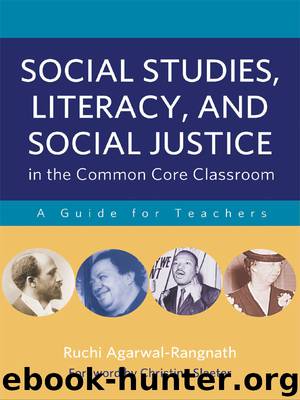Social Studies, Literacy, and Social Justice in the Common Core Classroom: A Guide for Teachers by Agarwal-Rangnath Ruchi

Author:Agarwal-Rangnath, Ruchi [Неизвестный]
Language: eng
Format: epub
Publisher: Teachers College Press
Published: 2013-04-21T21:00:00+00:00
CONCLUSION
The purpose of painting the picture is for students to think critically about the past through the exploration of multiple perspectives. To do this, we challenge students to explore their misconceptions around history, critically question the bias in text, and examine points of view that may be silenced or limited in textbooks. This tenet, in particular, is designed to get students thinking deeply and critically about social studies content.
As we explore the past through multiple perspectives, students come to grapple with history and decide for themselves what really happened. A teacher may use any variety of the strategies listed in this section. Each of the strategies requires a teacher to look outside the box to find resources that speak to a perspective that may be silenced in textbooks. By allowing the voices of those silenced to enter the mainstream narrative, students may see history in a different light. They may get to hear the stories of people who are like them and their struggle to overcome discrimination and racism. They may hear about their ancestors’ acts of resistance toward unfair practices and wages and also of their contribution to our country’s growth. They may also learn from stories of children, like Ruby Bridges, whose bravery and courage impacted change in our country. Last, they may hear of those who used their privilege and resources to serve as allies and support systems to those struggling to obtain freedom and rights. In each case, students may feel inspired and empowered to hear the stories of members of our society who fought against discrimination, racism, and oppression to make change in our world. Through the exploration of multiple perspectives, students may see that our country was built by the complex contributions of many people, not just the ones listed in our textbooks. Moreover, the stories of those who contributed to our country may not just be limited to stories of happiness and victory, but stories entangled with hardship, fear, anger, distrust, and worry. Our history is not a sanitized list of facts, but a complex and dynamic story that worked to give power to some and deny power to others.
Textbooks can also serve as valuable tools to help paint the picture. They can help students gain background information about the event, and the illustrations, photographs, and documents presented in textbooks can be used for an artifact analysis activity. When presenting information in textbooks, it is essential that we challenge our students to ask critical questions about the text so that they may be aware of bias. If we choose to only present the Eurocentric viewpoint present in textbooks, we prohibit our students from understanding history from multiple perspectives and seeing the struggles and contributions of people who helped create this nation. The textbook can serve as a tool for helping students gain one perspective, see the bias in curriculum, examine photographs and documents, and compare and contrast viewpoints.
Download
This site does not store any files on its server. We only index and link to content provided by other sites. Please contact the content providers to delete copyright contents if any and email us, we'll remove relevant links or contents immediately.
| Arts & Humanities | Health |
| Language Arts | Library Skills |
| Mathematics | Reading & Phonics |
| Science & Technology | Social Studies |
The Art of Coaching Workbook by Elena Aguilar(48067)
Trainspotting by Irvine Welsh(20057)
Twilight of the Idols With the Antichrist and Ecce Homo by Friedrich Nietzsche(17707)
Fangirl by Rainbow Rowell(7835)
Periodization Training for Sports by Tudor Bompa(7329)
Change Your Questions, Change Your Life by Marilee Adams(6642)
This Is How You Lose Her by Junot Diaz(5775)
Grit by Angela Duckworth(4738)
Red Sparrow by Jason Matthews(4668)
Asking the Right Questions: A Guide to Critical Thinking by M. Neil Browne & Stuart M. Keeley(4576)
Paper Towns by Green John(4169)
Room 212 by Kate Stewart(4108)
Ken Follett - World without end by Ken Follett(3973)
The Sports Rules Book by Human Kinetics(3589)
Housekeeping by Marilynne Robinson(3402)
The Motorcycle Diaries by Ernesto Che Guevara(3333)
Introduction to Kinesiology by Shirl J. Hoffman(3301)
Exercise Technique Manual for Resistance Training by National Strength & Conditioning Association(3292)
Double Down (Diary of a Wimpy Kid Book 11) by Jeff Kinney(3276)
